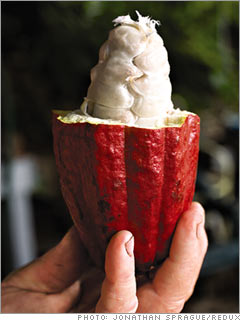The Coopers believe their chocolate-processing plant, at 1,152 square feet, is the world's smallest. To fit that size and the Coopers' largely self-funded budget - the production line is improvised. Bob Cooper cleans his beans with a rigged-up treadmill he bought used for $100. He cooks them in a coffee roaster and breaks the nibs from their shells with a homemade contraption built in part from a five-gallon bucket, plastic vacuum hoses, and a liberal smattering of duct tape. From there, his beans enter a $45,000 machine imported from Barcelona that, for 15 hours, churns the cacao into liquid and mixes it with cocoa butter, sugar, lecithin, vanilla and - for some batches - milk powder.
And the $10 pricetag on a three-ounce bar? I'd raise an eyebrow, but after seeing what goes into the product, I'm happy to support the operation, which for six years, as Bob puts it in a deadpan Southern twang, "has not been in danger of making money." This year he hopes for a small profit on his annual production of 6,000 to 8,000 pounds.
He also hopes that cacao might be the next major crop for Hawaiian agriculture - a dream far from being realized but not unrealistic. By most accounts, agriculture in the state is at a crossroads. Sugar cane production has fallen 75 percent in the past 20 years. From 2001 to 2005, pineapple cultivation statewide dropped from 20,000 acres to 14,000 acres; Del Monte recently announced its intention to close its Hawaiian pineapple operation in 2008. But while developers have bought much of that vacated farmland, other parcels have become small, diversified farms.
| |

